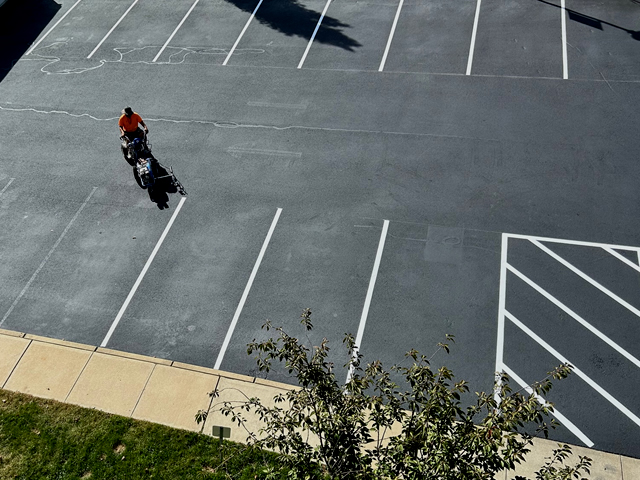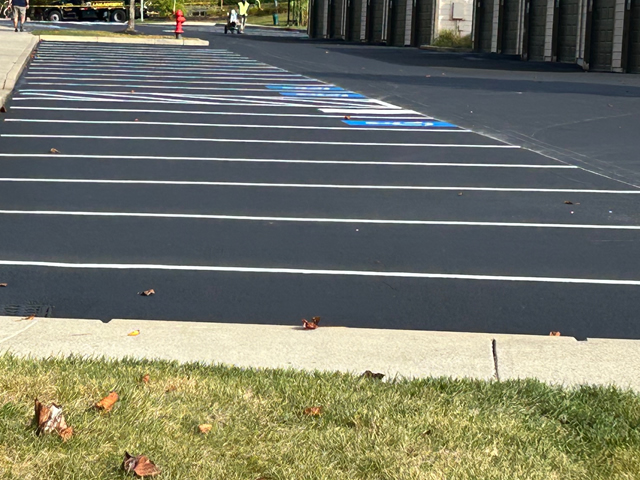Apartment Complex Parking Lot Striping: What You Need to Know
Parking lot striping for apartment complexes is essential for creating an organized, safe, and efficient parking environment. Properly striped parking lots not only enhance the appearance of the property but also ensure compliance with local regulations and optimize the use of available space.
Why Is Parking Lot Striping Important for Apartment Complexes?
Parking lot striping in apartment complexes is critical for organizing parking spaces, ensuring tenant safety, and meeting local compliance regulations. Without clear markings, confusion can arise, leading to accidents, parking disputes, and inefficiency.
An organized parking lot makes it easier for tenants and visitors to find parking and helps to prevent overcrowding. Clear markings also reduce the risk of fender benders and accidents, keeping the property safe and reducing liability for property owners.


Planning the Layout for Apartment Complex Parking Lots
Before striping begins, it’s essential to plan the layout carefully to maximize the number of parking spaces while ensuring compliance with safety regulations. This process should include the design of parking spaces, traffic lanes, and essential areas such as fire lanes, loading zones, and handicap-accessible parking.
Hiring a professional to develop a detailed layout plan is ideal. This ensures the parking lot meets all local requirements and is optimized for both vehicle flow and safety. A well-designed parking layout takes into account factors like tenant parking, visitor spaces, and designated areas for deliveries or emergency vehicles.
Standard Parking Space Dimensions for Apartment Complexes
The size of parking spaces is a key consideration when striping a parking lot for an apartment complex. Most standard parking spaces are 9 feet wide by 18 feet long, though these dimensions can vary based on local regulations or the specific needs of the complex. For example, compact parking spaces can be slightly smaller, while spaces for larger vehicles such as trucks or SUVs may need to be larger.
A professional layout plan will ensure the parking spaces are consistent, properly sized, and meet any local or state regulations regarding parking lot design. Proper spacing not only prevents parking disputes but also improves the overall flow of traffic within the lot.
Handicap-Accessible Parking Requirements
Handicap striping is a requirement. Apartment complexes must include handicap-accessible parking spaces as part of their striping layout. According to the Americans with Disabilities Act (ADA), a certain number of accessible spaces must be provided based on the total number of parking spaces in the lot.
Accessible parking spaces must be located near entrances or accessible paths to building entry points. These spaces need to be wider than standard spaces, typically 8 feet wide with an adjacent 5-foot access aisle. Van-accessible spaces require an 8-foot-wide access aisle to accommodate wheelchair lifts.
Including these spaces in the parking lot design ensures compliance with ADA requirements and provides equal access to all tenants and visitors.
Designating Visitor Parking Spaces
Visitor parking is an important consideration for apartment complex owners. Visitors need easy access to parking without taking up spaces designated for tenants. Clear signage and striping for visitor parking can help direct guests to the appropriate areas.
When laying out the parking lot, it’s helpful to include a specific section for visitor parking near the main entrances of the apartment complex. This prevents confusion for guests and ensures that tenant parking remains available for residents. In some cases, visitor parking may also include time limits to encourage turnover.
Fire Lane Marking and Compliance
Every apartment complex parking lot must include clearly marked fire lanes to allow emergency vehicles easy access to the property in the event of a fire or other emergency. Fire lanes are typically marked with red striping and labeled with “No Parking – Fire Lane” to ensure that these areas are kept clear.
Fire lanes are a legal requirement in most areas, and failure to comply with local fire codes can result in fines or safety violations. The layout plan should include these lanes in compliance with local fire safety regulations, ensuring that they are properly marked and maintained.
Maximizing Parking Efficiency with Clear Striping
Efficient parking lot striping is about more than just marking spaces. A well-designed layout optimizes the available space to fit the maximum number of parking spots while maintaining clear driving lanes and safe pedestrian paths.
Clear striping and directional arrows help guide drivers through the parking lot, reducing confusion and accidents. Designated pedestrian crosswalks, loading zones, and delivery areas can also be marked to keep these areas free of parked vehicles and promote safe access.
Parking Lot Striping Maintenance for Apartment Complexes
Maintaining the striping in your apartment complex parking lot is just as important as the initial striping process. Over time, paint can fade due to weather, sun exposure, and vehicle traffic. Faded striping makes parking spaces harder to see, leading to confusion, illegal parking, and safety hazards.
Regular maintenance and repainting will keep the striping bright and visible, ensuring the parking lot remains organized and safe. It’s recommended to repaint parking lot striping every 1 to 2 years, depending on traffic volume and environmental conditions.
Hiring a Professional Striping Contractor
To ensure that the striping is done correctly, it’s best to hire a professional parking lot striping contractor. Professional contractors have the expertise and equipment needed to apply striping that meets local regulations, lasts longer, and remains visible under various conditions.
A professional contractor will also help with the planning process, ensuring that the parking lot layout maximizes space and complies with local codes, including ADA requirements and fire lane regulations.
Key Considerations for Apartment Complex Parking Lot Striping
Parking lot striping for apartment complexes is essential for maintaining safety, organization, and compliance with local regulations. By investing in a professional layout plan, clearly marking handicap-accessible spaces, and maintaining fire lanes, property owners can ensure their parking lot operates efficiently. Regular maintenance and working with a professional striping contractor will keep the lot well-organized and ensure a positive experience for both tenants and visitors.

